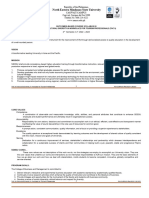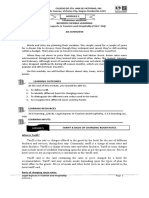0 ratings0% found this document useful (0 votes)
413 viewsTinola Is A Ginger and Onion Based Soup With Chicken As The Usual Main Ingredient. It Is Authentic To The
Tinola Is A Ginger and Onion Based Soup With Chicken As The Usual Main Ingredient. It Is Authentic To The
Uploaded by
JohnReyBarnacheaTinola is a chicken soup from the Philippines that has origins tracing back to Jose Rizal's novel Noli Me Tangere. The soup contains ginger, onions and chicken as main ingredients. Variants exist that substitute different vegetables like chayote or malunggay leaves. While the cooking method is unique to the Philippines, the ingredients have been influenced by countries like Spain, China, and the US. Tinola reflects how Philippine culture is a blend of different foreign influences combined with local customs.
Copyright:
© All Rights Reserved
Available Formats
Download as DOCX, PDF, TXT or read online from Scribd
Tinola Is A Ginger and Onion Based Soup With Chicken As The Usual Main Ingredient. It Is Authentic To The
Tinola Is A Ginger and Onion Based Soup With Chicken As The Usual Main Ingredient. It Is Authentic To The
Uploaded by
JohnReyBarnachea0 ratings0% found this document useful (0 votes)
413 views1 pageTinola is a chicken soup from the Philippines that has origins tracing back to Jose Rizal's novel Noli Me Tangere. The soup contains ginger, onions and chicken as main ingredients. Variants exist that substitute different vegetables like chayote or malunggay leaves. While the cooking method is unique to the Philippines, the ingredients have been influenced by countries like Spain, China, and the US. Tinola reflects how Philippine culture is a blend of different foreign influences combined with local customs.
Original Description:
Culinary Review
Original Title
Culinary Review
Copyright
© © All Rights Reserved
Available Formats
DOCX, PDF, TXT or read online from Scribd
Share this document
Did you find this document useful?
Is this content inappropriate?
Tinola is a chicken soup from the Philippines that has origins tracing back to Jose Rizal's novel Noli Me Tangere. The soup contains ginger, onions and chicken as main ingredients. Variants exist that substitute different vegetables like chayote or malunggay leaves. While the cooking method is unique to the Philippines, the ingredients have been influenced by countries like Spain, China, and the US. Tinola reflects how Philippine culture is a blend of different foreign influences combined with local customs.
Copyright:
© All Rights Reserved
Available Formats
Download as DOCX, PDF, TXT or read online from Scribd
Download as docx, pdf, or txt
0 ratings0% found this document useful (0 votes)
413 views1 pageTinola Is A Ginger and Onion Based Soup With Chicken As The Usual Main Ingredient. It Is Authentic To The
Tinola Is A Ginger and Onion Based Soup With Chicken As The Usual Main Ingredient. It Is Authentic To The
Uploaded by
JohnReyBarnacheaTinola is a chicken soup from the Philippines that has origins tracing back to Jose Rizal's novel Noli Me Tangere. The soup contains ginger, onions and chicken as main ingredients. Variants exist that substitute different vegetables like chayote or malunggay leaves. While the cooking method is unique to the Philippines, the ingredients have been influenced by countries like Spain, China, and the US. Tinola reflects how Philippine culture is a blend of different foreign influences combined with local customs.
Copyright:
© All Rights Reserved
Available Formats
Download as DOCX, PDF, TXT or read online from Scribd
Download as docx, pdf, or txt
You are on page 1of 1
BARNACHEA, John Rey M.
August 1, 2018
12 – Einstein st
21 Century Literature
Tinola: A Tale of Two Hemispheres
Tinola is a ginger and onion based soup with chicken as the usual main ingredient. It is authentic to the
Philippines and is best complimented with green papaya wedges and chili pepper leaves. However, there are
variants to this dish, such as using chayote or sayote as an alternative to papaya, as well as substituting malunggay
leaves for the chili pepper leaves (this one is for the health buffs out there). One can also add a lot of ginger to
help enhance the flavor of the soup, as well as add health benefits, although this doesn’t fare well with most
people. In the olden days, however, a live chicken is used, and, after slaughtering it, the chicken’s blood is mixed
with raw rice and put in the pot when everything is tender.
Despite being famous in the country, the origin of the dish is vague and unfamiliar to a lot of people. The
only historical account of tinola was when it was used in Jose Rizal’s novel Noli Me Tangere. In the story, the
considered ‘bad’ parts of the dish, like the chicken neck, were served to the Spanish friar Damaso, whereas the
‘good’ parts, like the breast and gizzard were given to the protagonist, Crisostomo Ibarra. It can be said that this
symbolizes how Rizal classified the characters – Ibarra being the lead character and Damaso being the antagonist.
It can also be interpreted as symbol of revolt, since tinola is native to our country, and, through the way it was
served in the story, the Spanish friar is unable to enjoy the dish. This can be a subtle way of saying that the
Filipinos during that time should not allow the Spanish priests and conquistadors to exploit resources that are
ours, be it endemic to our country or not. Either way, it is one of the rare instances in which a dish would be used
in a revolution, even if it’s just a small part.
The Philippines is a melting pot of Western and Asian cultures. Influences from countries like Spain, the
United States, China, and Japan are evident in our way of life, particularly in our food. Tinola is one example of
that. Perhaps the way of cooking can be considered unique to our country, but the ingredients are not. Let’s begin
with the Filipinos’ preference for soup. Most of our meals would not be complete without a liquid-based viand,
like sinigang, and nilaga. However, this idea is not entirely native to us. It was through trading with our neighbors
from the Northwest, the Chinese in particular, that the Filipinos came upon the practice of creating savory soup
bases. Unlike our other Asian neighbors, our soups are meant to be eaten as a meal in themselves, usually paired
with rice. The vegetables used, on the other hand, are products of Western agriculture. Papaya was introduced by
the Spaniards during the 333-year occupation of the country. Chayote, on the other hand, entered the country
through galleon trade, another product of the Spanish inquisition. Despite all of this, the dish still remains unique.
Perhaps our ancestors have infused their way of cooking to materials and concepts that were not yet found in the
country. The end result is one of the most famous soup-based dishes in the country.
At the end of the day, our culture really is like a jigsaw puzzle with parts coming from various parts around
the globe. Some parts look similar, some look very different from one another, but when pieced together they
form a picture, and that picture is our identity. We can all agree that being subjected to the rule of various countries
took a toll on our cultural identity. Currently, we are heavily Westernized, but some of our values and beliefs still
resemble our true origin. Indeed, our country is a bridge between the western and the eastern hemisphere.
References:
Ang Tinolang Manok ni Padre Damaso. (2018). Retrieved from https://www.spot.ph/arts-culture/46769/ang-tinolang-manok-ni-padre-
damaso
Chicken Tinola Recipe - Panlasang Pinoy. (2018). Retrieved from https://panlasangpinoy.com/2014/12/02/chicken-tinola-recipe/
Filipino Soups. (2018). Retrieved from http://famouswonders.com/filipino-soups/
You might also like
- Press: Chef Parvinder S. BaliDocument43 pagesPress: Chef Parvinder S. BaliWishal Shahi100% (2)
- 1.1 Culinary History TimelineDocument2 pages1.1 Culinary History TimelineJoemar Benito0% (1)
- My Lasagna RecipeDocument23 pagesMy Lasagna RecipeJohn OoiNo ratings yet
- The Complete Baking Book For Young Chefs: 100+ Sweet and Savory Recipes That You'll Love To Bake, Share and Eat!Document226 pagesThe Complete Baking Book For Young Chefs: 100+ Sweet and Savory Recipes That You'll Love To Bake, Share and Eat!董俊鑫100% (4)
- W11 Module 7 - Special FinancingDocument5 pagesW11 Module 7 - Special FinancingDanica VetuzNo ratings yet
- Code 130: Cfed 1033-Catholic Foundation of Mission: FinishedDocument1 pageCode 130: Cfed 1033-Catholic Foundation of Mission: FinishedRachel GreenNo ratings yet
- The Lifestyle of A VegetarianDocument2 pagesThe Lifestyle of A VegetarianCarlos DNo ratings yet
- BA 116 Standard Costing and Variance Analysis AssignmentDocument2 pagesBA 116 Standard Costing and Variance Analysis AssignmentearlanthonyNo ratings yet
- Industrial AgeDocument15 pagesIndustrial AgeJohnReyBarnachea100% (1)
- Graded Recitation RubricDocument1 pageGraded Recitation RubricJohnReyBarnachea75% (4)
- Bulk KFC Original Recipe Seasoning Copycat) Recipe - Food PDFDocument3 pagesBulk KFC Original Recipe Seasoning Copycat) Recipe - Food PDFrunner1968100% (1)
- F&B Basic HistoryDocument1 pageF&B Basic HistoryAbd Razak Ahmad100% (1)
- Strategy of Using Foreign Investors and LicenseeDocument2 pagesStrategy of Using Foreign Investors and LicenseeEros67% (3)
- Finals Reviewer Compilation of QuizzesDocument24 pagesFinals Reviewer Compilation of QuizzessofiaNo ratings yet
- BUSINESS IMPLEMENTATION FinalDocument53 pagesBUSINESS IMPLEMENTATION FinalFabiella MagbanuaNo ratings yet
- College For Research and Technology: Final ExaminationDocument2 pagesCollege For Research and Technology: Final Examinationjudea dizonNo ratings yet
- Activity On Cost-Benefit Analysis Scenario Benefits Costs AssessmentDocument2 pagesActivity On Cost-Benefit Analysis Scenario Benefits Costs AssessmentDaniel Victor AngNo ratings yet
- Endorsement Letter For Library UseDocument1 pageEndorsement Letter For Library UseMarjorie Dela CruzNo ratings yet
- Module On Banquet and CateringDocument169 pagesModule On Banquet and Cateringbarabas skyNo ratings yet
- THC 9Document10 pagesTHC 9Roselle BrillantesNo ratings yet
- LP-TVL-FBS-Napkin FoldingDocument3 pagesLP-TVL-FBS-Napkin Foldingalelirose.abalosNo ratings yet
- CHAPTER 1 The Social Dimension of Science Technology Technological Terminism and Construction of TechnologyDocument1 pageCHAPTER 1 The Social Dimension of Science Technology Technological Terminism and Construction of TechnologyMarcoNo ratings yet
- B&PAM Notes 1Document30 pagesB&PAM Notes 1Cris PorlasNo ratings yet
- Salient Changes Under The Revised Corporation CodeDocument3 pagesSalient Changes Under The Revised Corporation CodeLyka Lim PascuaNo ratings yet
- Historical Development of Art (First Half)Document48 pagesHistorical Development of Art (First Half)Elleonor Grace Apostol-PNo ratings yet
- TLE 10 Q1 Lesson 1Document23 pagesTLE 10 Q1 Lesson 1Angustia HalogNo ratings yet
- Baking I Course Syllabus Proposed FinalDocument8 pagesBaking I Course Syllabus Proposed Finaljermsemail0204100% (1)
- Midterm - Food and Beverage ServicesDocument1 pageMidterm - Food and Beverage ServicesJason YaraNo ratings yet
- SamsyupsolveDocument4 pagesSamsyupsolveAndee PatricioNo ratings yet
- CHAPTER 3&4 Multicultural Diversity in TourismDocument26 pagesCHAPTER 3&4 Multicultural Diversity in TourismFaith Rocero100% (1)
- History of Lodging IndustryDocument23 pagesHistory of Lodging IndustryStarlette Kaye BadonNo ratings yet
- IA - 2D Animation NC III v2Document23 pagesIA - 2D Animation NC III v2Jake Paras100% (1)
- Emmalyn Patindol Module in BusLaw Lessons 5Document35 pagesEmmalyn Patindol Module in BusLaw Lessons 5Emmalyn PatindolNo ratings yet
- Opening Statement DebateDocument2 pagesOpening Statement Debateneil john FrancilisoNo ratings yet
- Pungko-Pungko Social Convergence - A Culture Based Teaching StrategyDocument4 pagesPungko-Pungko Social Convergence - A Culture Based Teaching StrategyDan NacionNo ratings yet
- FSM 315 Module 15Document10 pagesFSM 315 Module 15Benjamin TaduranNo ratings yet
- Microeconomics Course Outline 2020Document3 pagesMicroeconomics Course Outline 2020Hendrix NailNo ratings yet
- GE 20 (Week 1-3)Document5 pagesGE 20 (Week 1-3)Renien Khim BahayaNo ratings yet
- IT Infrastructure in The Healthcare IndustryDocument7 pagesIT Infrastructure in The Healthcare IndustryHarsharaj MelantaNo ratings yet
- Philippine Women'S College of Davao: University Ave., Juna Subd., Matina, Davao CityDocument12 pagesPhilippine Women'S College of Davao: University Ave., Juna Subd., Matina, Davao CityGlyndon LaureanoNo ratings yet
- Quality Services Management I Tourism and HospitalityDocument5 pagesQuality Services Management I Tourism and HospitalityGladdelyn PiencenavesNo ratings yet
- Income Taxation ModuleDocument52 pagesIncome Taxation ModulePercival CelestinoNo ratings yet
- Formative Activity 2Document5 pagesFormative Activity 2uzzicauberNo ratings yet
- Food and Beverage Service Management 121219102040 Phpapp01Document109 pagesFood and Beverage Service Management 121219102040 Phpapp01Emerson CruzNo ratings yet
- Quiz-FS AnalysisDocument3 pagesQuiz-FS AnalysisVergel MartinezNo ratings yet
- Module 2. Rate, Tax, and Expenses (Legal Aspects)Document13 pagesModule 2. Rate, Tax, and Expenses (Legal Aspects)MARITONI MEDALLANo ratings yet
- Chapter 6 Customer Service and BehaviorDocument13 pagesChapter 6 Customer Service and BehaviorSisalNurdin0% (1)
- Reflection PaperDocument1 pageReflection PaperMikoToh ItoNo ratings yet
- Entrepmall GuidelinesDocument4 pagesEntrepmall GuidelinesMac b IBANEZNo ratings yet
- Commercial Cooking HandoutDocument16 pagesCommercial Cooking HandoutMay Joie JaymeNo ratings yet
- Chapter 1 STRAMADocument30 pagesChapter 1 STRAMAAnn Cruz100% (1)
- Laboratory Safety in The Clinical Microscopy SectionDocument6 pagesLaboratory Safety in The Clinical Microscopy SectionFarida WongNo ratings yet
- Chapter 1 SlidesDocument22 pagesChapter 1 SlidesSheena Doria de VeraNo ratings yet
- PPT-Ethics in International BusinessDocument12 pagesPPT-Ethics in International BusinessMaria Shaen VillanuevaNo ratings yet
- Basic Concepts of Ethics (UPDATED)Document11 pagesBasic Concepts of Ethics (UPDATED)ARJUN ABUBAKARNo ratings yet
- Gender and SexismDocument8 pagesGender and Sexismpipul36No ratings yet
- Lesson 9 - Sanitary Facilities Pest ManagementDocument6 pagesLesson 9 - Sanitary Facilities Pest ManagementJoana Mae GuevarraNo ratings yet
- Importance of Knowledge of Laws in The HospitalityDocument7 pagesImportance of Knowledge of Laws in The HospitalityGeeanNo ratings yet
- Values EducationDocument96 pagesValues EducationRicky ProctanNo ratings yet
- Catering Halls: Independent CaterersDocument3 pagesCatering Halls: Independent Caterersbshm thirdNo ratings yet
- CHAPTER I General Concepts and Historical Events in STSDocument25 pagesCHAPTER I General Concepts and Historical Events in STSFromilan BaduriaNo ratings yet
- G-10 2ND QUARTER EXAM 2022 CookeryDocument3 pagesG-10 2ND QUARTER EXAM 2022 CookeryMarlou Chester BendañoNo ratings yet
- Hospitality HM 5Document12 pagesHospitality HM 5Rosille Villanueva100% (1)
- Course Outline Managerial AccountingDocument5 pagesCourse Outline Managerial AccountingShobha SheikhNo ratings yet
- FILCUI1 PaperDocument3 pagesFILCUI1 Paperjose-pocholo-g-berdan-6131No ratings yet
- 2327 9834 Article p809Document3 pages2327 9834 Article p809davideNo ratings yet
- Central Asian LiteratureDocument39 pagesCentral Asian LiteratureJohnReyBarnacheaNo ratings yet
- AuthorsDocument3 pagesAuthorsJohnReyBarnacheaNo ratings yet
- Notebook 2ndQDocument7 pagesNotebook 2ndQJohnReyBarnacheaNo ratings yet
- Olympiad Number Theory PDFDocument123 pagesOlympiad Number Theory PDFJohnReyBarnacheaNo ratings yet
- Similarity PDFDocument1 pageSimilarity PDFJohnReyBarnacheaNo ratings yet
- Sigma Notation and The Telescoping Technique: Series AnalysisDocument5 pagesSigma Notation and The Telescoping Technique: Series AnalysisJohnReyBarnacheaNo ratings yet
- Ucsp Paper 2Document2 pagesUcsp Paper 2JohnReyBarnacheaNo ratings yet
- Regional Team Orals 2013Document2 pagesRegional Team Orals 2013JohnReyBarnacheaNo ratings yet
- Narrative ReportDocument1 pageNarrative ReportJohnReyBarnachea67% (3)
- MMC National Finals Individual CategoryDocument2 pagesMMC National Finals Individual CategoryJohnReyBarnacheaNo ratings yet
- Regional Team Orals 2013Document2 pagesRegional Team Orals 2013JohnReyBarnacheaNo ratings yet
- MMC National Finals Individual CategoryDocument2 pagesMMC National Finals Individual CategoryJohnReyBarnacheaNo ratings yet
- Mtap 2013 HSDocument8 pagesMtap 2013 HSDex Valdez0% (1)
- Math Challenge 2013 Individual Finals 3 RD Year Cat ADocument1 pageMath Challenge 2013 Individual Finals 3 RD Year Cat ADex ValdezNo ratings yet
- Reflective Essay (Biodiversity)Document2 pagesReflective Essay (Biodiversity)JohnReyBarnachea0% (1)
- George Orwell (1903 - 1950)Document9 pagesGeorge Orwell (1903 - 1950)JohnReyBarnacheaNo ratings yet
- Mapeh 9 ModuleDocument10 pagesMapeh 9 ModuleJohnReyBarnachea80% (5)
- Grade 9 2015 MTAP ChallengeDocument5 pagesGrade 9 2015 MTAP ChallengeJohnReyBarnacheaNo ratings yet
- The Three Musketeers: List of CharactersDocument15 pagesThe Three Musketeers: List of CharactersJohnReyBarnacheaNo ratings yet
- Proposed Title: Lumpiang AmpalayaDocument2 pagesProposed Title: Lumpiang AmpalayaEvan BoaloyNo ratings yet
- File Test 1 Grammar, Vocabulary, and Pronunciation A: Grammar 1 Underline The Correct FormDocument6 pagesFile Test 1 Grammar, Vocabulary, and Pronunciation A: Grammar 1 Underline The Correct FormКостя Шульга0% (1)
- Fundamental and Culinary Arts ReviewerDocument3 pagesFundamental and Culinary Arts ReviewerJalareNo ratings yet
- Feasibility - CostingDocument5 pagesFeasibility - CostingRonabel BelonioNo ratings yet
- True Texas Chili RecipeDocument2 pagesTrue Texas Chili RecipeleeleegarciaNo ratings yet
- DLL Tle-He 6 q1 w6Document5 pagesDLL Tle-He 6 q1 w6Maestro GallaNo ratings yet
- ReadingDocument18 pagesReadingNhựt LamNo ratings yet
- Menu Rotasi Sarapan Hotel Permata Hijau (Es)Document1 pageMenu Rotasi Sarapan Hotel Permata Hijau (Es)Erick SaputraNo ratings yet
- Harvest Moon Resep MasakanDocument3 pagesHarvest Moon Resep MasakanIrawan ParmaNo ratings yet
- Types of RestaurantDocument6 pagesTypes of RestaurantAnne LealNo ratings yet
- University of The Immaculate Conception Bonifacio Street, Davao CityDocument97 pagesUniversity of The Immaculate Conception Bonifacio Street, Davao CityTrisha Andrea LimNo ratings yet
- Kitchen: Complete The 15 Sentences With The Words On The LeftDocument2 pagesKitchen: Complete The 15 Sentences With The Words On The LeftStefan JosephNo ratings yet
- SFBB Daily Record Sheet Catering 2005Document2 pagesSFBB Daily Record Sheet Catering 2005Cresophy ShresthaNo ratings yet
- Sports Nutrition Recipe BookDocument20 pagesSports Nutrition Recipe BookPetar GranićNo ratings yet
- The Happy PearDocument8 pagesThe Happy PearEricka AlejosNo ratings yet
- Feature Writing EnglishDocument2 pagesFeature Writing EnglishAldren BababooeyNo ratings yet
- ماكولات اليبيةDocument9 pagesماكولات اليبيةميسي ميسيNo ratings yet
- Mealshare #Buy1give1 Vegetarian Honey: 2100 Dollarton Hwy ColonynorthwoodsDocument2 pagesMealshare #Buy1give1 Vegetarian Honey: 2100 Dollarton Hwy ColonynorthwoodsMario CoronadoNo ratings yet
- Lesson 2 Biscuits PDFDocument11 pagesLesson 2 Biscuits PDFKrupaNo ratings yet
- Procedure TeksDocument20 pagesProcedure TeksMuh FajarrachmanNo ratings yet
- Meniu: Pensiune Restaurant PiscinaDocument14 pagesMeniu: Pensiune Restaurant PiscinaMadalina CristeaNo ratings yet
- Ultimate Cooking HandbookDocument54 pagesUltimate Cooking HandbookhishimmyNo ratings yet
- The World's Best Chocolate Cake Recipe - Life, Love and SugarDocument3 pagesThe World's Best Chocolate Cake Recipe - Life, Love and SugarJennifersherlynNo ratings yet
- How To Prepare Bisibelebath (A Tasty South Indian Dish) - 13 StepsDocument7 pagesHow To Prepare Bisibelebath (A Tasty South Indian Dish) - 13 StepsAnonymous N2Q5M6No ratings yet
- Spicy Shrimp Chao Fan RecipeDocument41 pagesSpicy Shrimp Chao Fan RecipeMichael Albano100% (1)
- Spices Rates 28-6-2021Document4 pagesSpices Rates 28-6-2021kartikNo ratings yet












































































































